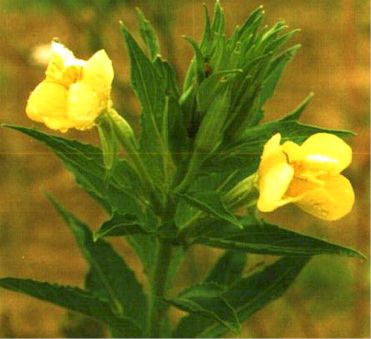
Evening Primrose Oenothera spp.

Evening Primrose Oenothera spp.
Named for its habit of opening its blooms at dusk, Evening Primrose is found all over California. The flowers are 4-petaled, large and yellow, white, rose, or violet, and have a characteristic X-shaped stigma. The inflorescence is a raceme-like spike; but sometimes flowers grow from the axils of the topmost reduced leaves. This plant can reach 8 feet, though some species are somewhat prostrate. The downy leaves arrive in a basal rosette the first year. Afterward they grow alternately from a stem, are numerous, lanceolate, and pinnately toothed to lobed. The fruits are elongated capsules with many, many tiny seeds.
Evening Primrose is one of the best and easiest to harvest sources of Omega 3 essential fatty acids (EFAís). Omega 3 oils prevent the arachidonic acid cascade, also known as the metabolic pathway to pain. The cascade is a complex process involving the breakdown of metabolic acids into either inflammatory or beneficial prostaglandins, depending upon an individualís predisposition to certain illnesses. Omega 6 EFAís like olive-, soy-, and corn oils, cause this cascade. Evening Primrose seeds contain Omega 3 oil.
Inflammatory conditions such as eczema, psoriasis, have been treated both internally and externally with Oenothera. Canada permits dietary supplementation of Evening Primrose oil. And in England, it is used topically for eczema. Only supplement laws protect the use of Evening Primrose oil in the US, however.
Traditional external uses include poulticing the root for the treatment of hemorrhoids and bruises. But the fresh or dried leaves can be used to make poultices, infusions, or salves to treat the same conditions, especially eczema. In fact, some eczema sufferers have reduced or eliminated their dependence on steroid-based medications through the topical use of Evening Primrose.
Internally, the seed oil or ground seeds have been used to treat asthma, migraines, arthritis, and other inflammatory conditions. Research has shown Omega 3 oils to be beneficial in the lowering of cholesterol and slowing its production. The vasodilatory effects of the seed oil have been used also to treat hypertension and heart diseases.
Migraines, often brought on by the arachidonic acid cascade, may also benefit from the use of the seed oil. The above are mainly preventative measures. But the seeds or seed oil have been used for symptomatic treatment as well.
Other internal uses involve taking leaf infusions to increase mental alertness, and to relieve anxiety and depression. How Evening Primrose works in these cases is not exactly known. But it is believed that the plantís mucilage has a beneficial effect on the stomach, liver, and spleen, and that the feelings of well-being stem follow these physiological effects. Leaf infusions are also used to ease coughs and sore throats. In this case the action is directly attributed to the mucilage. Oenothera infusions have been used to relieve dyspepsia, and the root tea was used to treat obesity. It is high in potassium and magnesium.
Every part of the plant is edible. Beginning with the taproot, which can be steamed, boiled, or fried, the young leaves of the basal rosette can be used in salads (although I have used the smallish leaves growing up the mature stalk, too), or as a potherb. As with most wild edibles, the younger leaves are always best (donít forget the downy texture; use sparingly). But the older leaves can be used as you would the younger leaves. The flowers make a pretty addition to salads.